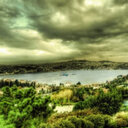Detection of diabetic foot hyperthermia by using a regionalization method, based on the plantar angiosomes, on infrared images.
Słowa kluczowe
Abstrakcyjny
Prevention of serious diabetic foot complication like ulceration or infection is an important issue. As the development of thermal graphic technologies, foot temperature-guided avoidance therapy has been recommended. Doctors from Hospital National Dos de Mayo are studying on the risk of the diabetic foot passing from Grade 0 to Grade 1 in the Wagner Scale. This risk to develop ulcers is related to the temperature difference of corresponding area between left and right foot. Generally speaking, the diabetic foot with greater mean temperature difference has more potential to develop ulcers; especially, area whose temperature difference of more than 2.2°C is where doctors and patients must pay much attention to potential problems like ulceration or infection. A system in Visual Studio was developed taking the thermal images as input and producing image with absolute mean temperature difference of 7different regions or four plantar angiosomes as output. The program process contained essential medical image processing issues such as segmentation, location and regionalization, in which adapted algorithms were implemented. From a database of 85 patients provided only 60 were used due to the quality of acquisition.


